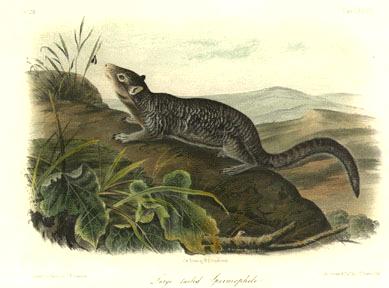

139 Large-tailed Spermophile
SPERMOPHILUS MACROURUS.--BENNETT.
[Spermophilus variegatus]
LARGE-TAILED SPERMOPHILE.
[Rock Squirrel]
PLATE CXXXIX.--MALE
S. Magnitudine Sciurum cinereum adequans, vellere crassiusculo, in dorso
lateribusque cinereo nigroque vario, cauda corporis longitudine mediocriter
comosa.
CHARACTERS.
Size of the cat-squirrel (Sciurus cinereus); fur, rather coarse; body,
mottled with black, and ashy white, forming irregular interrupted narrow
transverse bars on the back and sides; tail, as long as the body, and moderately
bushy.
SYNONYMES.
SPERMOPHILUS MACROURUS. Bennett, Proc. Zool. Soc., 1833, p. 41.
LONG-TAILED MARMOT. Zool. Soc. Catalogue, No. 456.
SCIURUS LUPTUS. Named in the Museum of the Jardin des Plantes, but not
described.
DESCRIPTION.
This animal is shaped very much like a squirrel, although the ears are
farther back in the head and the body is stouter than in that genus. Head, of
moderate size, round, and elongated; nose, somewhat pointed; ears, large, broad,
and ovate towards the points; feet, stout; nails, long, sharp, and considerably
arched; tail, rounded, possessing none of the distichous arrangement of the
tails of squirrels; tarsi, naked beneath; fur, moderately long, and rather
coarse and harsh to the touch.
COLOUR.
Hairs of the back, blackish-gray at the base, annulated with white, or
brownish-white, towards the tips, which are black; crown of the head, pure
black; muzzle, rufous brown above, whitish on the sides; a narrow whitish space
around the eyes; on the lower part of the cheeks and on the throat the hairs are
brownish-white; cheeks, grizzled black and white; ears, internally covered with
short hairs and partly coloured on the inner surface with dusky and soiled
yellow; on the outside they are blackish-brown, becoming paler and grizzled
towards the margins; feet, whitish, finely freckled with dusky markings, their
general hue pale; tail, moderately bushy and sub-depressed; the hairs are long,
varying from one and three quarters to two inches in length; they are of a
brownish-white colour and are annulated by three broad black rings, the
annulations nearest the apex of each hair considerably broader than the others.
Upper and lower incisors, pale yellow; whiskers, black; claws, brown.
In the specimen here described the whole crown of the head is black, but we
are informed by our friend WATERHOUSE that an imperfect skin of a second
specimen which exists in the museum of the Zoological Society of London has the
crown of the head gray.
DIMENSIONS.
Foot. Inches. Lines.
Length from point of nose to root of tail,. . 1 1 0
Length of tail (vertebrae),. . . . . . . 0 7 9
Length of tail (including hair), . . . . . 0 10 0
Length from nose to ear,. . . . . . . . 0 2 5
Height of ear, . . . . . . . . . . . 0 0 6
Heel to end of claws,. . . . . . . . . 0 2 5
Length of nail of middle hind-toe, . . . . 0 0 4 1/2
Length of fore-foot and nails,. . . . . . 0 1 6
Length of nail of middle toe of fore-foot,. . 0 0 4 1/2
HABITS.
Spermophilus Macrourus is an active and sprightly fellow, readily ascending
trees on occasion, and feeding on nuts as well as seeds, roots, and grasses.
This species is in some districts rather numerous, and when in the rainy
season some of the low grounds are submerged, takes to the trees, and sometimes
curious fights occur between it and the wood-peckers. Five or six of the latter
will on observing the Spermophile, unite against him, and cutting about in the
air, peck at him as they dart swiftly around the persecuted animal, which is
lucky if a hollow into which he can retreat be near, and frequently indeed the
wood-peckers' holes are entered by him, but the angry and noisy birds still keep
up their cries and fly with fury at the hole, and although they can no longer
peck the animal they keep him in a state of siege for a considerable time.
The origin of this animosity may be the fact of the Spermophile (as well as
many kinds of squirrels) sometimes turning out the wood-peckers from their
nests, an injury which unites them against the wrong-doer. By what process the
birds are influenced to attack when the animal is not in their nests, nor even
on a tree upon which they have built (or dug, we should say), we know not, but
that the birds comprehend that union is strength is quite evident, and the
Spermophile knows it too, for he always instantly tries to escape and conceal
himself as soon as the vociferous cries of the first bird that observes him are
heard, and before its neighbours called thereby to the fight can reach the spot.
We have not been able to ascertain how many young this Spermophile produces
at a birth, nor at what season they are brought forth. It is seen on the plains
and in localities where no trees grow, in which places it burrows or runs into
holes in the rocks.
From our present information we are inclined to think that this species is
sometimes in company with S. Douglasii in California, or at least inhabits the
same districts.
GEOGRAPHICAL DISTRIBUTION.
This Spermophile exists in some portions of that part of Mexico which were
traversed by J. W. AUDUBON on his way towards California, and is also found in
the last named State.
GENERAL REMARKS.
This species somewhat resembles Spermophilus Douglasii, but is a larger
animal, the white patches over the shoulders moreover are wanting. The heel is
hairy beneath, but the remaining part of the under surface of the foot is naked,
whilst in Spermophilus Douglasii the whole foot is covered with hair beneath, up
to the fleshy parts at the base of the toes.
|